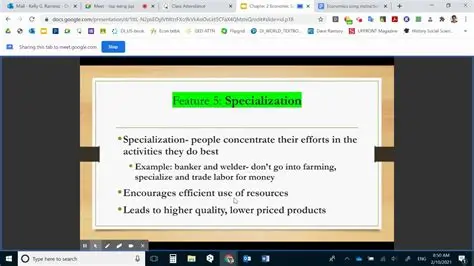Introduction: Understanding the Pure Market Economy
In the world of economics, various systems and theories exist to describe how economies operate. One such concept is the pure market economy, which operates on specific principles distinct from other economic systems. In this blog post, we will delve into the characteristics of a pure market economy, including the absence of government intervention in the market, the private ownership of resources and means of production, the reliance on prices to determine the allocation of resources, and the pivotal role of competition as the driving force of the economy. By exploring these subheadings, readers will gain a deeper understanding of what sets a pure market economy apart from other economic models and the implications of such a system on businesses, consumers, and overall economic growth. So, let’s dive into the world of pure market economies and uncover the key traits that define this unique economic system.
Characteristics of a Pure Market Economy
A pure market economy is defined by certain key characteristics that set it apart from other economic systems. One of the primary features of a pure market economy is the absence of government intervention in the market. This means that the government does not interfere with the production, distribution, or pricing of goods and services. Instead, these decisions are made by the interactions of supply and demand in the market.
Another defining characteristic of a pure market economy is the private ownership of resources and means of production. In this type of economy, individuals and businesses have the right to own and control the factors of production, such as land, labor, and capital. This allows for a high degree of autonomy and freedom for individuals to make economic decisions based on their own interests.
In a pure market economy, prices determine the allocation of resources. The forces of supply and demand dictate the prices of goods and services, which in turn influence how resources are allocated. This means that resources are allocated to their most efficient uses based on consumer preferences and market demand.
Finally, competition is the driving force of the economy in a pure market economy. With minimal government regulation, businesses are able to compete freely with one another, which encourages innovation, efficiency, and consumer choice. Competition ensures that businesses strive to provide high-quality products at competitive prices, ultimately benefiting consumers.
Absence of Government Intervention in Market
One of the defining characteristics of a pure market economy is the absence of government intervention in the market. In this type of economy, the government plays a minimal role in regulating economic activities, and there are few, if any, restrictions on the interactions between buyers and sellers.
Without government intervention, market forces such as supply and demand are allowed to operate freely, determining prices and the allocation of resources. This means that businesses are free to set their own prices and make their own production and investment decisions, based on what they believe will be most profitable.
Proponents of this economic system argue that the absence of government intervention allows for greater efficiency and innovation in the economy, as businesses are incentivized to compete and find new ways to attract customers and improve their products and services.
However, critics argue that the absence of government intervention can lead to inequality and exploitation of workers and consumers, as businesses may prioritize profits over the well-being of their employees and customers. They also raise concerns about the potential for market failure and the negative impact on the environment without government regulations in place.
Private Ownership of Resources and Means of Production
Private ownership of resources and means of production is a fundamental characteristic of a pure market economy. In such an economic system, individuals and businesses have the right to own and control their own resources, such as land, labor, and capital. This means that the decision-making power regarding the allocation and use of these resources lies in the hands of private individuals rather than the government.
One of the main advantages of private ownership is that it encourages entrepreneurship and innovation. When individuals have the incentive to invest in and make the most of their resources, they are more likely to come up with new ideas and technologies that can drive economic growth and prosperity. Private ownership also allows for a greater diversity of products and services, as different individuals and businesses pursue their own unique interests and goals.
However, private ownership also comes with its challenges. Inequality is a common concern in pure market economies, as those who own more resources have greater power and influence. This can lead to disparities in wealth and opportunities, which may be seen as unfair or unjust by some. Additionally, the profit motive of private ownership can sometimes lead to exploitation of labor and natural resources, as individuals and businesses seek to maximize their own gains.
Despite these challenges, private ownership of resources and means of production remains a defining feature of many modern economies. It plays a crucial role in shaping the way resources are allocated, goods and services are produced, and wealth is distributed within a society.
Prices Determine Allocation of Resources
One of the key characteristics of a pure market economy is that prices play a crucial role in determining how resources are allocated. In this type of economic system, the forces of supply and demand interact to set prices for goods and services. When demand for a particular product or service is high, prices tend to rise, signaling to producers that there is an opportunity to make a profit by providing more of that product or service. On the other hand, when demand is low, prices tend to fall, indicating to producers that they may need to reduce their output or find ways to make their products more attractive to consumers.
This system of price determination has significant implications for how resources are allocated within the economy. When prices are high, producers have an incentive to allocate more resources to the production of the goods or services that are in high demand, as they stand to make a greater profit. Conversely, when prices are low, producers may choose to reallocate resources to other areas where they see greater potential for profit. This means that in a pure market economy, resources are allocated based on the signals sent by prices, rather than by government direction or central planning.
One of the key advantages of this system is that it allows for a high degree of flexibility and responsiveness to changing market conditions. Because prices are constantly adjusting in response to changes in supply and demand, resources can be quickly reallocated to where they are most needed. This can help to ensure that resources are used efficiently and that consumers are able to get the goods and services they want. Additionally, the competition that arises from the price determination process can help to drive innovation and improve the quality of goods and services available to consumers.
However, it’s important to recognize that this system is not without its drawbacks. In some cases, prices may not accurately reflect the true value of goods and services, leading to inefficiencies in resource allocation. Additionally, the reliance on prices to determine allocation means that certain essential goods and services may be underproduced if there is not a profitable market for them. This can create challenges in ensuring that all members of society have access to basic necessities.
Competition as the Driving Force of the Economy
Competition plays a crucial role in shaping the dynamics of a market economy. In the absence of government intervention, competition becomes the driving force that determines the allocation of resources. When businesses are compelled to compete with one another, they are motivated to innovate, offer better products and services, and operate more efficiently in order to gain a competitive edge. This ultimately benefits consumers as they have access to a wider variety of goods and services at competitive prices.
Furthermore, competition fosters an environment of continuous improvement and growth. Businesses are constantly striving to improve their products and operations in order to stay relevant in the market. This relentless drive for improvement fuels innovation and ultimately leads to technological advancements, better quality products, and improved productivity. All of these factors contribute to the overall growth and development of the economy.
In addition, competition promotes efficiency in the allocation of resources. In a competitive market, businesses are incentivized to operate efficiently in order to minimize costs and maximize profits. This efficiency extends to the allocation of resources, as businesses are motivated to use their resources in the most effective and productive manner possible. As a result, resources are allocated to their most productive uses, contributing to the overall economic efficiency of the market.
Overall, competition serves as the driving force that fuels growth, innovation, and efficiency within a market economy. It encourages businesses to continually strive for improvement, benefits consumers by offering a wider array of choices, and ensures that resources are allocated to their most productive uses. Therefore, fostering healthy competition is essential in creating a dynamic and thriving market economy.
Frequently Asked Questions
What are the characteristics of a pure market economy?
The characteristics of a pure market economy include private ownership of resources and means of production, prices determining allocation of resources, absence of government intervention in the market, and competition as the driving force of the economy.
How does a pure market economy differ from other types of economies?
A pure market economy is distinguished by its lack of government intervention in the market and the reliance on prices and competition to allocate resources, in contrast to mixed or command economies where the government plays a more active role in resource allocation.
What is the role of competition in a pure market economy?
Competition is the driving force of a pure market economy, as it encourages efficiency, innovation, and lower prices for consumers. It also serves to allocate resources to the most efficient producers.
Why is private ownership of resources important in a pure market economy?
Private ownership of resources encourages individuals to use their resources in the most efficient way to maximize their own profit, leading to a more efficient allocation of resources in the economy.
How are prices determined in a pure market economy?
In a pure market economy, prices are determined by the interaction of supply and demand. When demand for a particular good or service increases, prices tend to rise, signaling to producers to increase supply.
What are the potential drawbacks of a pure market economy?
Some potential drawbacks of a pure market economy include income inequality, lack of public goods provision, and potential market failures, such as monopolies or negative externalities, which may require government intervention.
How does a pure market economy impact consumer choice?
A pure market economy offers a wide range of choices for consumers, as producers compete to offer the best products at the lowest prices. This competition encourages innovation and variety in goods and services.







